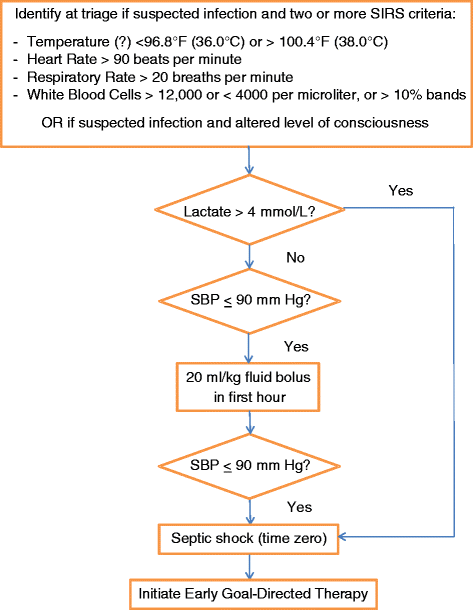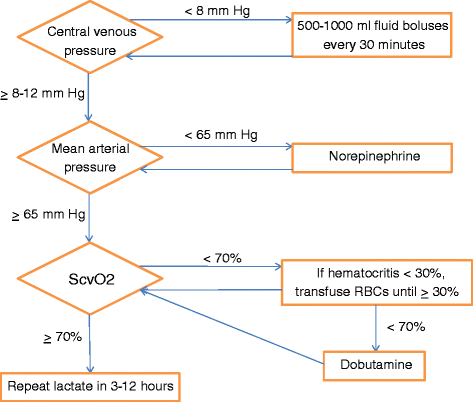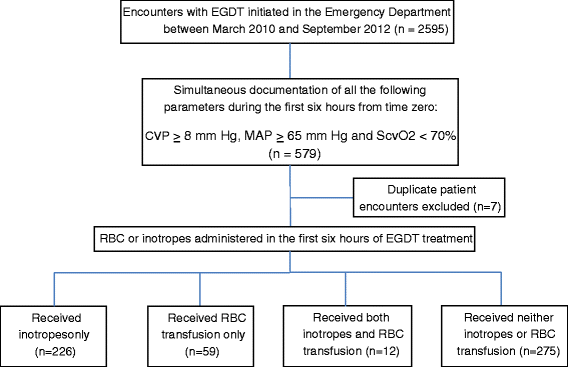In-hospital mortality following treatment with red blood cell transfusion or inotropic therapy during early goal-directed therapy for septic shock: a retrospective propensity-adjusted analysis
- PMID: 25212411
- PMCID: PMC4181703
- DOI: 10.1186/s13054-014-0496-y
In-hospital mortality following treatment with red blood cell transfusion or inotropic therapy during early goal-directed therapy for septic shock: a retrospective propensity-adjusted analysis
Abstract
Introduction: We sought to investigate whether treatment of subnormal (<70%) central venous oxygen saturation (ScvO2) with inotropes or red blood cell (RBC) transfusion during early goal-directed therapy (EGDT) for septic shock is independently associated with in-hospital mortality.
Methods: Retrospective analysis of a prospective EGDT patient database drawn from 21 emergency departments with a single standardized EGDT protocol. Patients were included if, during EGDT, they concomitantly achieved a central venous pressure (CVP) of ≥8 mm Hg and a mean arterial pressure (MAP) of ≥65 mm Hg while registering a ScvO2 < 70%. Treatment propensity scores for either RBC transfusion or inotrope administration were separately determined from independent patient sub-cohorts. Propensity-adjusted logistic regression analyses were conducted to test for associations between treatments and in-hospital mortality.
Results: Of 2,595 EGDT patients, 572 (22.0%) met study inclusion criteria. The overall in-hospital mortality rate was 20.5%. Inotropes or RBC transfusions were administered for an ScvO2 < 70% to 51.9% of patients. Patients were not statistically more likely to achieve an ScvO2 of ≥70% if they were treated with RBC transfusion alone (29/59, 49.2%, P = 0.19), inotropic therapy alone (104/226, 46.0%, P = 0.15) or both RBC and inotropic therapy (7/12, 58.3%, P = 0.23) as compared to no therapy (108/275, 39.3%). Following adjustment for treatment propensity score, RBC transfusion was associated with a decreased adjusted odds ratio (aOR) of in-hospital mortality among patients with hemoglobin values less than 10 g/dL (aOR 0.42, 95% CI 0.18 to 0.97, P = 0.04) while inotropic therapy was not associated with in-hospital mortality among patients with hemoglobin values of 10 g/dL or greater (aOR 1.16, 95% CI 0.69 to 1.96, P = 0.57).
Conclusions: Among patients with septic shock treated with EGDT in the setting of subnormal ScvO2 values despite meeting CVP and MAP target goals, treatment with RBC transfusion may be independently associated with decreased in-hospital mortality.
Figures



References
-
- Dellinger RP, Levy MM, Rhodes A, Annane D, Gerlach H, Opal SM, Sevransky JE, Sprung CL, Douglas IS, Jaeschke R, Osborn TM, Nunnally ME, Townsend SR, Reinhart K, Kleinpell RM, Angus DC, Deutschman CS, Machado FR, Rubenfeld GD, Webb SA, Beale RJ, Vincent JL, Moreno R. Surviving sepsis campaign: international guidelines for management of severe sepsis and septic shock: 2012. Crit Care Med. 2013;41:580–637. doi: 10.1097/CCM.0b013e31827e83af. - DOI - PubMed
Publication types
MeSH terms
Substances
LinkOut - more resources
Full Text Sources
Other Literature Sources
Miscellaneous

